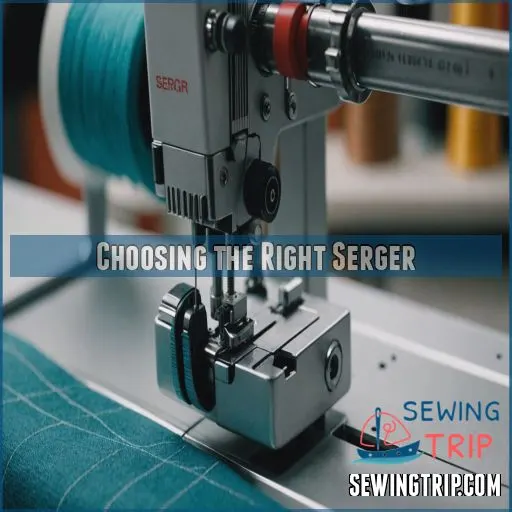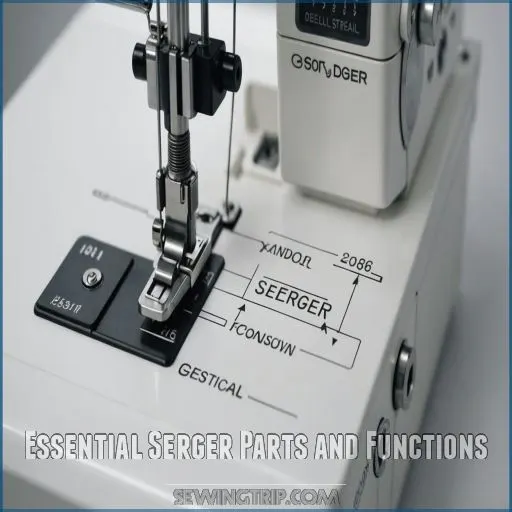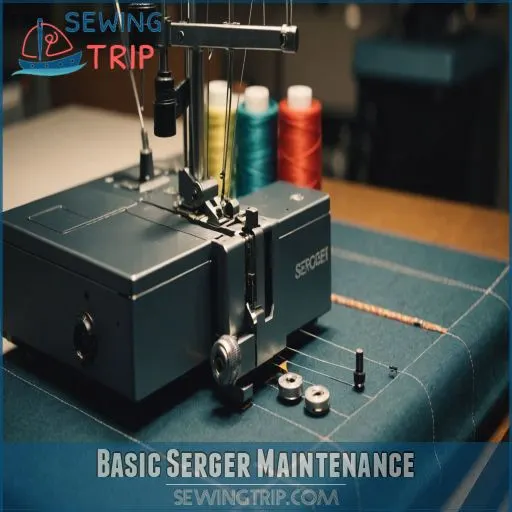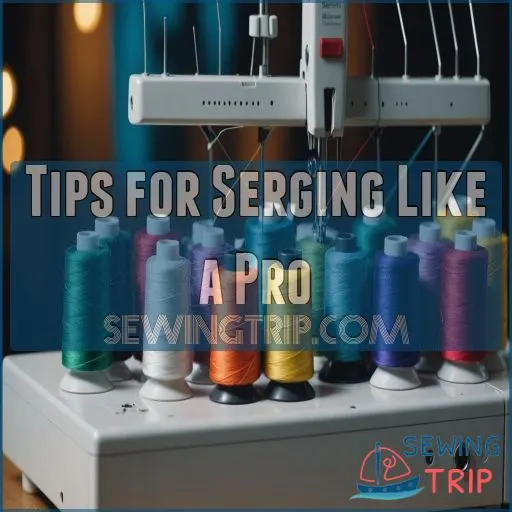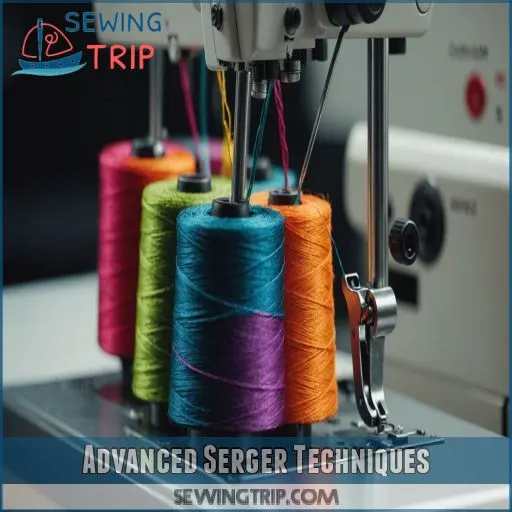This site is supported by our readers. We may earn a commission, at no cost to you, if you purchase through links.
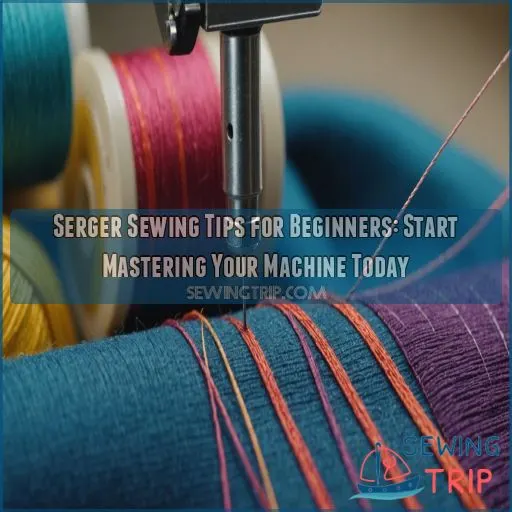 If you’re itching to get started with your serger, you’re in for a treat—it’ll revolutionize your sewing game!
If you’re itching to get started with your serger, you’re in for a treat—it’ll revolutionize your sewing game!
Start by choosing a beginner-friendly model; the Brother 1034D or Baby Lock Victory are popular picks.
Get comfy with adjusting thread tension and stitch length; think of it as finding the sweet spot in a new pair of shoes.
Practice threading, and remember your foot pedal isn’t a gas pedal in a race—smooth control is key!
With a little TLC, like regular oiling and dusting, your serger will purr along beautifully.
Ready for some serging magic? Let’s unravel those hidden techniques!
Table Of Contents
Key Takeaways
- Choose a Beginner-Friendly Serger: Starting with the right serger is like setting the foundation for a sturdy house. Opt for models like the Brother 1034D or Baby Lock Victory to kick off your sewing journey without draining your wallet. These machines will be your trusty sidekicks as you dive into the serging world.
- Threading and Tension: Mastering the art of threading your serger is akin to solving a well-crafted puzzle. Embrace the learning curve and practice until you can do it with your eyes closed. Adjusting thread tension and stitch length is crucial—think of it as finding the sweet spot in a new pair of shoes.
- Foot Pedal Control and Sewing Speed: Your serger’s foot pedal isn’t a race car accelerator, but more like a dance partner. Learn to control the speed smoothly to achieve consistent, neat stitches. Aiming for speed control bliss ensures projects come out looking professional, not like a toddler’s crayon masterpiece.
- Regular Maintenance: Keep your serger purring like a content kitten by treating it to regular oiling and dusting. Consider maintenance as a small act of kindness—skip it and risk your machine sounding like a grumpy dinosaur instead of your creative ally.
Choosing the Right Serger
Choosing your first serger can feel like picking your Hogwarts house—exciting but a little overwhelming!
We’ll guide you through the magical features to look for and help you find budget-friendly options that won’t make your wallet scream.
Features to Consider for Beginners
When choosing a serger as a beginner, focus on user-friendly features that make your life easier.
Look for adjustable thread tension and stitch length to control your stitching magic, like the Singer 14CG754 ProFinish.
A responsive foot pedal is your best friend for pacing.
Consider a machine with minimal noise—your ears will thank you!
Plus, easy-to-thread needle types simplify the process.
Happy serging!
Budget-Friendly Options for Sergers
Don’t let the price tag scare you – there are plenty of budget-friendly serger options out there.
The Brother 1034D and Baby Lock Imagine (or Victory) are great picks for beginners.
With a little research, you can find a reliable serger that fits your sewing needs and your wallet.
The key is finding the right balance of features and affordability.
Essential Serger Parts and Functions
Getting to know your serger’s parts is like befriending a quirky companion with a need for speed.
From mastering the threading process without tangling to using the foot pedal for graceful stitch control, you’ll soon be laughing at your early sewing misadventures.
Understanding the Threading Process
You’ve picked the right serger; now let’s unravel the mystery of threading it.
Navigate the threading sequence like a pro with high-quality thread.
Avoid threading mistakes by checking the looper tension.
Getting Familiar With the Foot Pedal Control
Mastering your serger’s foot pedal pressure is like learning to drive a stick shift—tricky at first, but you’ll soon find speed control bliss.
Practicing starting/stopping helps improve stitch quality.
Adjusting the Stitch Length and Width
Adjusting the stitch length and width is a breeze once you get the hang of it.
Play around with different settings to see how they impact your fabric – a tighter stitch is great for delicates, while a wider one works wonders on bulky materials.
Experiment and find your sweet spot!
Basic Serger Maintenance
Keeping your serger in tip-top shape doesn’t have to be a chore—it’s all about a little regular TLC, like oiling and dusting, which helps your machine purr like a content kitten.
Don’t wait until it sounds like a dinosaur roaring; with a dash of attention, you’ll prevent common issues and keep your creativity flowing.
Regular Oiling for Optimal Performance
Consistency is key for good serger performance, so keep oiling part of your sewing ritual.
Here’s how:
- Use high-quality sewing machine oil for lubrication.
- Oil every 15 hours of use.
- Don’t drench it—just a couple of drops, like seasoning a salad!
Dusting and Cleaning the Serger
After keeping your serger well-oiled, focus on dusting and cleaning.
Using serger cleaning tools helps maintain performance.
Dust removal tips include using a small brush or air blower.
Clean regularly, like clockwork, to keep your serger sewing smoothly and extend its life.
Troubleshooting Common Issues
Uh oh, your serger acting up? Don’t sweat it – with a little troubleshooting, you’ll have it purring like a kitten.
Check for thread tangles, adjust those tensions, and give it a good dusting.
Serger issues are no match for your problem-solving skills!
Mastering Basic Serger Techniques
When you first start using a serger, it’s a bit like riding a bike—fast and intimidating, but with practice, you’ll soon feel the wind in your hair.
Master the basics by threading the serger with ease, controlling speed with the foot pedal, and balancing tension for those perfect stitches that won’t unravel faster than a mystery novel.
Threading the Serger With Ease
Threading a serger can seem like a monster at first, but once you know the threading order, it’s a breeze!
Different serger models may vary, so consult your manual’s troubleshooting tips.
Controlling the Speed With the Foot Pedal
With a little foot pedal pressure finesse, you’ll master serger sewing in no time!
Speed control techniques let you achieve consistent stitching whether you’re starting or stopping.
Slow stitching isn’t a slog; it’s a savvy strategy.
Consider serger tutorials or videos for more tips!
Balancing the Tension for Perfect Stitches
Balancing your serger’s tension is key to achieving perfect stitches.
Start by consulting your machine’s tension chart, then make micro-adjustments as needed.
Three tips: 1) Loosen upper looper tension for a smoother finish, 2) Tighten lower looper tension for a tighter stitch, and 3) Experiment until you find the sweet spot.
Tips for Serging Like a Pro
Ready to serge like a pro?
Let’s tackle those tricky aspects like using the stitch finger for guidance, managing your pins and fabric placement, and steering clear of some common serging slip-ups.
Using the Stitch Finger for Guidance
Keep your serger’s stitch finger as vigilant as a hawk!
Its precise placement prevents fabric wraps and improves stitch quality.
Like a dance, guide your serger fabric flow smoothly.
Mastering this skill helps you get great results with your serger.
Voilà, serger patterns are your playground!
Managing Pins and Fabric Placement
In serger sewing projects, proper pin placement is super important.
Steer clear of disaster by placing pins at least three inches from the cutting blade.
Or forego pins entirely and use basting spray or serger clips to keep fabric feeding smoothly and seamlessly.
Avoiding Common Mistakes and Errors
Oops, don’t let those pesky serger snafus trip you up! 1) Double-check your threading order. 2) Swap out dull needles for fresh ones. 3) Tame tricky fabric with the differential feed – it’s your secret weapon against puckering and stretching.
Serging Different Fabrics and Projects
Mastering your serger means tackling fabrics as varied as knits, wovens, and all those tricky corners and curves.
Don’t be surprised if your first attempts look like a toddler’s art project,
but with practice, you’ll create seams that are smoother than a cat’s purr!
Working With Knit Fabrics and Stretchy Materials
Feeling like a serger pro? Knit fabrics and stretchy materials are your next challenge, like when sewing bathing suit fabric!
Sergers are fab for **knit and stretchy fabrics**, preventing fraying with smooth seam finishing and perfect edges, [a great example of a hand-serged seam](https://sewingtrip.com/how-to-serge-by-hand/).
Playing with a lettuce edge adds flair too—easy peasy!
Serging Woven Fabrics and Delicate Materials
Silk and delicate fabrics can feel tricky, but serging them is a breeze!
Balance thread tension carefully and select the right needles.
Opt for shorter stitch settings for precision.
Think of your serger as a magical assistant guiding you—sewing straight and true!
Tips for Serging Curves and Corners
Serging curves and corners takes a light touch.
Ease the fabric through gently, adjusting stitch length and tension as needed.
Don’t force it – let the serger glide smoothly around those tricky spots.
With a little practice, you’ll be serging like a pro in no time!
Common Serger Troubleshooting
Think your serger has a mind of its own, causing threads to break or stitches to go wonky?
Let’s tackle these common issues head-on, so you can confidently troubleshoot and keep your serger sewing smoothly.
Thread Breakage and How to Fix It
When serging fabric, you might face thread breakage.
It’s like hitting a bump on a smooth road.
Fix it by:
- Checking thread tension and quality.
- Removing any knots in the thread path.
- Inspecting for needle damage or looper issues.
Keep calm and serge on!
Uneven Stitching and How to Adjust
After fixing thread breakage, you’re greeted by uneven stitching, huh? No worries! Adjust the thread tension, triple-check the needle type, and tweak that differential feed for fabric finesse.
Also, playing with stitch length can work wonders.
Practice makes perfect, seriously! Happy serging!
Machine Noise and Vibration Issues
Hear that rattling? Chances are, your serger’s got some loose parts that need tightening. Or maybe the needle’s gone wonky.
Don’t sweat it – a quick tune-up can quiet that noisy machine right down.
Just follow the manual and you’ll be humming along in no time.
Advanced Serger Techniques
Ready to take your serging skills to the next level?
We’ll explore exciting techniques like creating a perfect rolled hem and playing with the differential feed—no magic wand required, just your trusty serger and a dash of confidence!
Creating a Rolled Hem With Your Serger
So, you’ve decided to tackle a serger rolled hem? Bravo!
Try these tips:
- Choose lightweight fabrics.
- Adjust tension settings until just right.
- Experiment with stitch length for that flawless finish.
Enjoy the challenge!
Using the Differential Feed for Unique Effects
Once you’ve tackled rolled hems, give your fabric texture a creative twist with the differential feed.
This nifty feature lets you create beautiful lettuce edges and ruffled hems, adding impressive stitch variations and unique finishes.
Serger Communities and Forums for Support
Join online serger communities to connect with fellow enthusiasts, share tips, and troubleshoot issues. These supportive forums offer a wealth of knowledge to elevate your sewing game.
Recommended EBooks and Classes for Learning
Hungry for more serger wisdom?
Check out ebook reviews and serger classes for a deeper understanding.
Online tutorials also offer treasure troves of learning, bringing those nifty techniques right to your fingertips!
Frequently Asked Questions (FAQs)
How do I finish seams without a serger?
When life gives you thread and fabric but no serger, embrace the trusty zigzag stitch!
Sew your seams with love using a zigzag or pinking shears to keep those edges neat.
It’s like a dance party for fabric!
Can I use a serger to sew buttonholes?
How do I store my serger when not in use?
Handle your serger with care, like a mighty sword resting in its sheath.
Store it dust-free, cover it up, and keep it safe from moisture.
Find it a snug spot, and it’ll last longer!
Can I use regular sewing thread in a serger?
While you can use regular sewing thread in a pinch, it’s not the ideal choice.
Serger thread is thinner and more durable, designed to withstand the high speeds of your serger, and it’s a great choice for managing serging thick layers.
Stick with serger-specific thread for best results.
How do I adjust the stitch length on a serger?
Imagine your serger as a speedboat in need of steering adjustments.
Simply turn the stitch length dial, typically on the right side, to change the distance between stitches.
A trial run on scrap fabric never hurts!
Conclusion
Imagine sewing a cozy winter scarf with your newly mastered serger—it feels like magic, doesn’t it?
Now that you’re equipped with serger sewing tips for beginners, you’re ready to transform your sewing projects.
Embrace the learning curves, keep practicing, and maintain your machine, and soon you’ll serge like a pro.
So, keep experimenting, enjoy the process, and watch your skills flourish!
You’ve totally got this!

